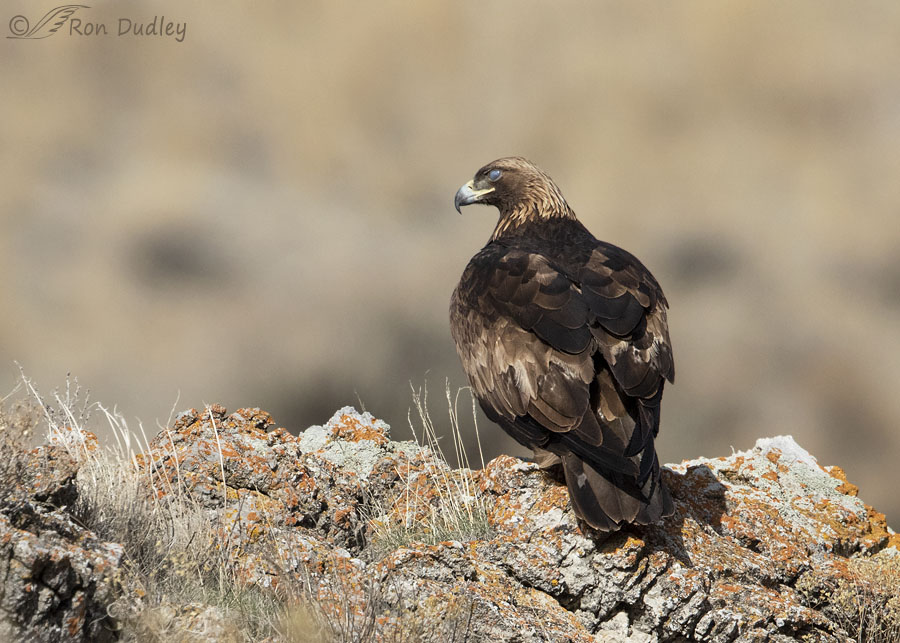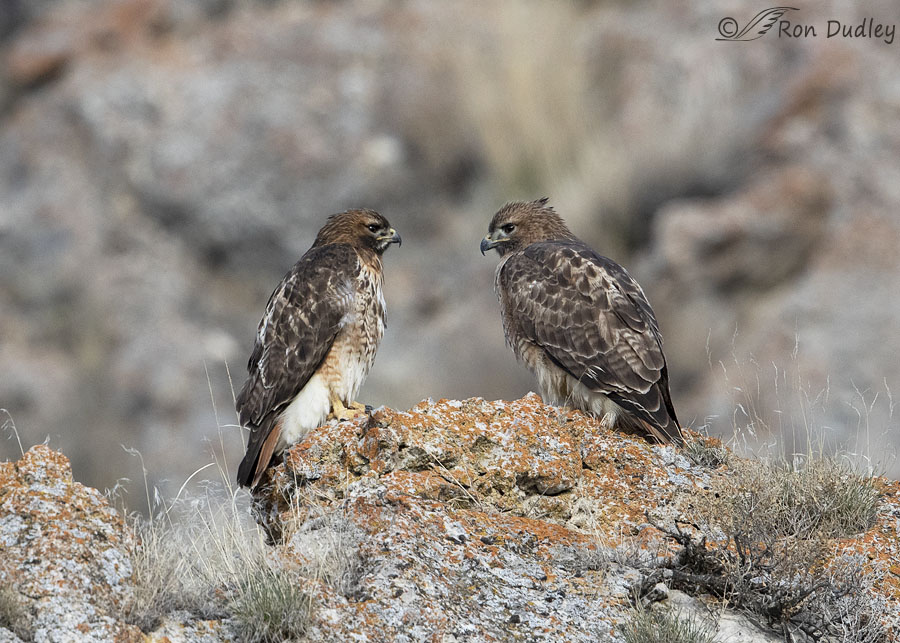Unfortunate timing with a Golden Eagle and a minor mystery with a mated pair of Red-tailed Hawks.
A couple of little things from my morning in the field three days ago that my mind keeps going back to.

Blog followers know that I have a near-obsession with Golden Eagles. But they’re hard to find and they tend to be extremely shy so getting decent photos of them is a tall order. When I do find one more often than not it’s perched on an unattractive utility pole so it really get’s my heart pumping when I find one in an attractive natural setting.
I was driving slowly on a remote road when we found two Golden Eagles perched on attractive lichen-covered rocks in good light on my left – this is one of them. The gloriously magnificent eagle had its back to me but it was close and its head was turned my way so damned right, I wanted photos. By the time I got my pickup stopped and my lens out the window I only had time for this single shot before the eagle looked forward and took off away from me. Not an ideal photo but it was a Golden Eagle so during the long drive home I kept hoping it was sharp. It was.
I hadn’t even considered the possibility that the eagle would choose the exact split second my shutter fired to blink its nictitating membrane. But that’s exactly what happened so its eye is distractingly cloudy. I have nothing against nictitating membranes but I generally prefer that they not be closed in my photos.
A near-everyday occurrence for me when I’m photographing birds but when it happens with a Golden Eagle in a natural setting like this its unusually painful.

In yesterday’s post I mentioned that I’d seen four pairs of mated Red-tailed Hawks that morning – this is one of them. I’m always happy to get two raptors in the same photo, especially when they’re in an attractive natural setting. These two love birds may look like they’re glaring at each other but I think that’s inaccurate. I wouldn’t be surprised if they had actually mated just before I pulled up on them.
Something unusual about this photo jumps out at me. Notice that the catch light in the eye of the bird on the left is at 3 o’clock on the eyeball but the catch light of the other bird is at 9 o’clock. Normally that shouldn’t happen when the two birds are this close to each other – both catch lights should be at the same place on their respective corneas. It almost looks like a natural catch light had been missing on the hawk on the right and the photographer (me) had pulled some hanky-panky and added a fake catch light. I didn’t.
This photo was taken in a remote location so I can only surmise that the catch light of one of the birds is a reflection off of my pickup.
I’m sure my readers care far less than I do about both events I’ve described and illustrated here. But as the photographer I think about this stuff and sometimes it ends up on my blog.
Ron
Addendum:
In the comments below several readers whose judgment I respect have challenged my explanation for the position of the catch light in one of the hawks in the photo above. However, at this point I’m still not seeing it that way, no matter how hard I try (which may be related to the reason my degree is in biology and not physics… 🙂 ). I’m not saying I’m right, only that I don’t see the logic of any of the alternative explanations. Not yet anyway.
At some point, possibly soon, I may publish a post devoted exclusively to this subject. Maybe then I’ll ‘see the light’.


I agree entirely with the Dan Gleason’s theory. That’s my perspective too.
A Golden!!! I’m calling this a total win because I know you’ve been trying to get a nictitating membrane shot — and you nailed it! Couldn’t get that shot again if you tried! 😉
And thank you for sharing Red-Tail “afterglow.” The tousled, bed-head feathers totally make the shot for me. 🛏
Got a huge whiff of orange blossom when I opened the windows this morning. Both trees are covered in blooms (even though they’re still full of oranges). 🍊
That’s it, Marty. I was TRYING for that shot of the membrane! Thanks, now I feel like I accomplished something with it.
👍
Reference Ed Kings response…. get a couple marbles and a flashlight and try to replicate what Ed is suggesting.
I have another idea other than marbles, Gary. We’ll see if anything comes of it.
I am so very grateful to you and to your knowledgeable commentators. My education continues.
So does mine, EC. In spite of my apparent denseness at times.
Nictitating membrane and mysteriously placed catch lights have no impact on my admiration for both of these beautiful images (though I agree a clear Golden eye would be better). But I am wondering how these raptors seem to know the little “issues” that will confound you when they become your photographic subjects. 😉
Chris, I don’t know how they know but they certainly seem to. And then they spring it on me…
Great photo even if the membrane got in the way. All of my rather poor photos of Golden Eagles are on poles because they are usually too far away for any photo.
The catchlight on the hawks doesn’t seem mysterious to me. If the birds heads were in the same plane, the catchlight should be in the same place. But if one bird has its head slightly turned away that would change where the light reflects from the eye, as it does here. Additionally, birds eyes are not perfect spheres. A very slight difference in the surface of the eye combined with a slightly different angle to the light, could easily result in catchlights that are in different places with respect to each eye.
Thank you Dan.
Thanks, Dan. Please see my addendum at the end of this post.
The Golden Eagle is beautiful and spooky at once.
In The Case of the Divergent Eye Catches:
If there was a reflection from your truck might that not result in a double eye catch for one or both Hawks, unless the angle of your truck’s reflection coincides with the sun’s?
The more likely explanation is that the remote location for this photo was much more remote than you let on: you took this photo on Tatooine.
I’ll admit it, Lyle – I had to look up Tatooine. But then I’ve seen very few of the Star Wars movies.
I think Ed King’s post is interesting. In addition, the birds’ eyes are not perfect spheres sand their heads are not placed exactly the same. I have been trying to understand reflections lately. (Called “Covid obsession!) And the phenomenon is probably more physics than my aging brain can wrap itself around. But Ed’s explanation makes sense to me. My latest confusion came when I looked out of a south window and saw a tree I didn’t recognize. Then I realized It was a reflection. But of what? I didn’t see the real tree where I expected it to be. It was, in fact, the reflection of a reflection, of a tree in the northeast corner of the yard, first reflected in an east window. I now notice this oddness in almost window in that room when the sun is low in the east.
Sallie, reflections can often have a similar effect to optical illusions – some mirages for example. They throw the brain for a loop.
Two very appealing natural photos that I really like…throw in some great lichens and I’m more than pleased. Love the quiet moment between the two Red Tails…sometimes I feel like I’ve shared a special instant with photos like this. Thanks for sharing this. I was thinking along the same lines as Ed’s comment to the difference catch light positions also before I read his response. Did you catch the PBS show last night ‘H is for Hawk’ featuring the gal who wrote the book…her experiences training a Goshawk. The images of those birds maneuvering through dense forests is beyond amazing! I’m definitely
going to have to read her book.
I read her book years ago Kathy – it is about time I read it again. I hope you enjoy it as much as I did.
EC….I shall let you know…I so enjoyed the show on PBS.
Kathy, I still haven’t read her book. When I get my cataracts fixed I should put it at the top of my list.
Always something “different” and interesting….😀 If one didn’t know about the nictitating membrane one would thing the eagle had a bad eye….😉 They are magnificent creatures even with the “eye thing”. The hawk thing is a bit of a puzzle unless the one on the left’s head was turned just enough? Oh well! Beautiful shot regardless!
Judy, It always bothers me a little when I complain about the membrane when it shows in my photos. That membrane is natural and for their sake I’m sure glad they have it. So who am I to bellyache about it…
Excellent photos as always. Getting two hawks together is a good find. I don’t think I have more than one or two photos of two together in almost 15 years of photographing them. Not one of your followers would accuse you of tinkering with catch-eyes. That is a beautiful Golden Eagle photo nictitating membrane or not. The light is perfect showing off the various colors and shades of her back feathers.
Thank you, Everett.
The two hawks do look a bit disgruntled. The one in the right also has a case of bed head.
Bed head indeed.
I recently got a great shot of a pileated wood pecker working an aspen trunk during a snow squall. The photo is everything I could hope for with one exception. The bird’s eye is completely covered by a falling snow flake. What are the odds? Pretty good actually, with bird photography!
I’ve had that happen too, Porcupine – a fair number of times. Frustrating…
Ron. If you look closely, the eye surfaces for both birds are slanted away from the camera by about the same amount. Also, the sun is almost directly behind you — no shadows leaning left or right. So the catchlights in both eyes are right where the curved surface of each eye is perpendicular to that sunlight coming from directly behind you. Neither catchlight is likely a reflection off your vehicle.
I can be a little dense but I’m not getting your point, Ed. The eyes are spheres so it seems to me that it shouldn’t make any difference which way the eyes are “slanted”. If both catch lights are direct reflections of the sun they should be at the same place on the corneas of both birds with them this close together…?
Ed, please see my addendum at the end of this post.
By the way, it was good to jabber-jaw with you for a while in the field this morning!